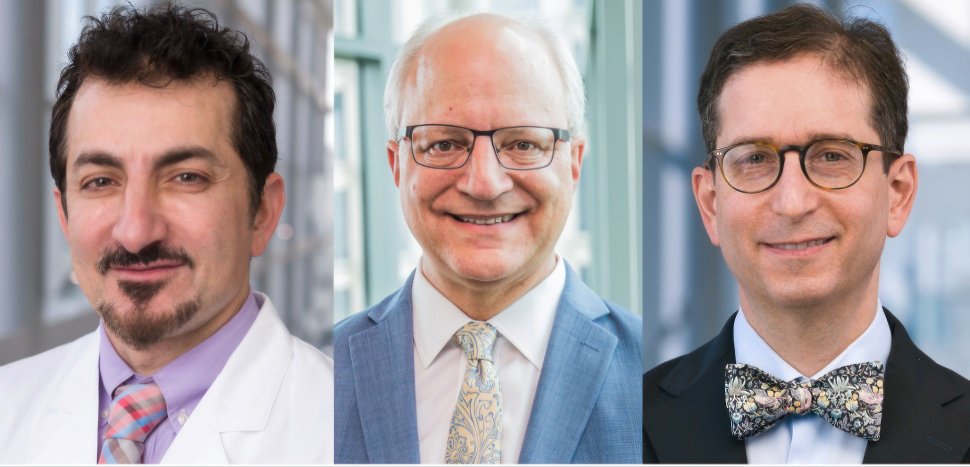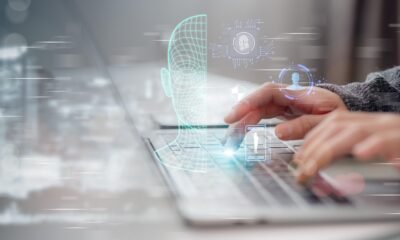AI Research
OPINION: Artificial intelligence driven scams: Attacking your business and personal life – The Paducah Sun

AI Research
NIH Taps UT Southwestern Medical Center for $23M North Texas Alzheimer’s Disease Research Hub » Dallas Innovates

The leadership team for UT Southwestern’s new North Texas Alzheimer’s Disease Research Center includes principal investigator Dr. Ihab Hajjar (left), O’Donnell Brain Institute director Dr. William Dauer, and neurology chair Dr. Elan Louis. Their work will push the frontier of dementia research, as well as support community outreach and training for caregivers. [Photos: UT Southwestern Medical Center]
North Texas is the newest federal front line in the fight against Alzheimer’s and dementia.
The National Institute of Health has awarded UT Southwestern a $23 million, five-year grant from the National Institute on Aging to establish the North Texas Alzheimer’s Disease Research Center (ADRC). The designation makes it one of 37 such centers nationwide and the second in Texas, according to an announcement.
The new center, based at UT Southwestern Medical Center, will be a focal point for research that could reset how the disease is detected and treated. Scientists plan to probe how cardiometabolic conditions like high blood pressure accelerate dementia, train AI to hear vocal cues of cognitive decline, and build digital replicas of patients to test therapies.
Texas by the numbers
Texas, which is the nation’s second most populous state, has the third-highest number of Alzheimer’s patients, the second-highest Alzheimer’s-related deaths, and the highest dementia burden score, according to UTSW. The dementia burden score is a measure of the emotional and psychological toll on caregivers.
That reality, paired with UT Southwestern’s long-standing strength in neurology and its Peter O’Donnell Jr. Brain Institute, laid the groundwork for the designation.
Tackling cardiometabolic factors in dementia and more
Each Alzheimer’s Disease Research Center operates with a unique theme. In North Texas, the focus will be on advancing the national agenda by exploring how cardiometabolic factors, especially hypertension, contribute to Alzheimer’s and related dementias. Hypertension affects nearly 120 million Americans, according to UTSW.
The center also plans to use AI voice analysis to discover vocal changes that accompany cognitive decline. Researchers will develop “digital twin” technology to create virtual representations of patients, which will help distinguish between factors associated with normal aging and those linked to dementias, according to Dr. Ihab Hajjar, principal investigator of the new center.
“Being named an ADRC is not only an indication of scientific excellence, but also highlights an intentional commitment to research Alzheimer’s disease and cognitive impairment in our community,” said Hajjar, who is professor of neurology and internal medicine at UT Southwestern, in a statement.
Hajjar said the designation gives North Texas “the chance to make an unprecedented leap in understanding and treating Alzheimer’s disease and related dementias.”

Dr. Ihab Haijar [Photo: UT Southwestern Medical Center]
North Texas collaboration in the dementia fight
The designation is designed in collaboration with UT Dallas and UT Arlington.
The North Texas ADRC will not only enable new science but also “enhance scientific and clinical collaborations locally and nationally” while creating education opportunities for researchers, clinicians, and learners, according to UTSW.
Dr. William T. Dauer, director of the Peter O’Donnell Jr. Brain Institute, points to the new designation as proof of what can happen when institutions combine their strengths.
“This designation reflects the power of bringing together outstanding scientists, clinicians, and community partners to tackle one of the most urgent societal challenges,” Dauer said in the announcement. “It will strengthen our ability to link discoveries from O’Donnell Brain Institute laboratories with the needs of patients and families in North Texas and beyond, accelerating progress against Alzheimer’s disease and related dementias.”
Dr. Elan D. Louis, chair and professor of neurology and an investigator in the O’Donnell Brain Institute, noted that the ADRC reflects momentum already underway across his department.
“Our new ADRC reflects a growing emphasis in the Department of Neurology on learning about, understanding, and treating a group of disorders that affect millions of elderly people nationwide,” Louis said.
Feeding a national data engine for dementia research
The research generated by all ADRCs will feed into communal datasets that are made publicly available to spur collaboration and speed discovery. Hajjar said those shared efforts could offer “hope to patients with dementia and their loved ones.”
Dementia research is a core area within UTSW, and the new center builds on a decade of work by the O’Donnell Brain Institute.
UTSW also notes its No. 9 ranking for Neurology & Neurosurgery on U.S. News & World Report’s Best Hospitals list and 12 nationally ranked specialties, the most of any hospital in Texas. To date, its faculty have received six Nobel Prizes and include 24 members of the National Academy of Sciences, 23 members of the National Academy of Medicine, and 13 Howard Hughes Medical Institute Investigators.
Leadership brings specialized expertise
UTSW said the center’s leadership team brings long-standing expertise in neurological research with distinct but complementary focuses. Dr. Dauer holds the Lois C.A. and Darwin E. Smith Distinguished Chair in Neurological Mobility Research. Dr. Hajjar holds the Pogue Family Distinguished University Chair in Alzheimer’s Disease Clinical Research and Care, in Memory of Maurine and David Weigers McMullan. Dr. Louis holds the Linda and Mitch Hart Distinguished Chair in Neurology.
The ADRCs were established in 1984 as congressionally designated NIH Centers of Excellence. The mission includes improving detection, diagnosis, treatment, prevention, and care for patients and families. Each center tailors its theme to local populations and scientific priorities.
The North Texas center joins another Texas ADRC, a collaboration between UT Health San Antonio and The University of Texas Rio Grande Valley designated in 2021, strengthening the state’s role in national dementia research efforts.
Don’t miss what’s next. Subscribe to Dallas Innovates.
Track Dallas-Fort Worth’s business and innovation landscape with our curated news in your inbox Tuesday-Thursday.
AI Research
xAI CFO Mike Liberatore Leaves After About 3 Months
AI Research
How AI Upended a Historic Antitrust Case Against Google

When the United States Justice Department first sued to break up Google alleging that it illegally monopolized online search in October 2020, there was little indication that one of the biggest factors in the case would be the rapid rise of a nascent technology.
On Tuesday, US District Court Judge Amit P. Mehta ordered Google to stop using exclusive agreements with third-parties to distribute its search engine, but stopped short of forcing the company to cease such payments altogether or to spin off its Chrome web browser.
The decision over legal remedies in the case deals a significant blow to US antitrust enforcers after securing a historic ruling declaring that Google maintained an illegal monopoly last year.
Notably, Mehta’s 226-page liability decision heavily emphasized the role that the ascendance of artificial intelligence, particularly generative AI (or “GenAI”) products like OpenAI’s ChatGPT, played in his assessment of the case.
“The emergence of GenAI changed the course of this case,” Mehta wrote in his 226-page ruling.
Tech Policy Press reviewed Mehta’s mentions of AI tools and companies and his characterization of Google’s position in this emerging market to see how his assessment of the technology impacted his deliberations. Here’s what we found:
A blip during liability discussion, a major talking point over remedies
Google’s competitive position in the booming yet still emerging AI market featured prominently in Mehta’s decision Tuesday, a contrast with his earlier ruling finding that Google monopolized online search. As CNBC reported, “OpenAI’s name comes up 30 times, Anthropic is named six times and Perplexity shows up in 24 instances. …ChatGPT was named 28 times in Tuesday’s filing.” Aside from OpenAI, the companies had not yet been founded when the case was filed.
Additionally, “AI” and “artificial intelligence” were mentioned 116 times combined, generative “artificial intelligence,” “generative AI” and “GenAI” were referenced 220 times, and “large language models” and “LLM” were mentioned 82 times, according to our review.
By contrast, Mehta barely made reference to AI’s rise in his decision declaring Google a monopoly last year. In that 286-page decision, Mehta mentioned ChatGPT only twice, and OpenAI, Perplexity and Anthropic not at all. “Generative artificial intelligence” was mentioned seven times, while “generative AI” and “GenAI” were not referenced at all, and “large language model” and “LLM” were referenced only a dozen times.
Mehta himself alluded to this discrepancy, noting that the tools played a far bigger role in the latter remedies phase of the trial than the earlier liability phase. While no AI competitors have yet to make gains on Google, Mehta wrote, the tools “may yet prove to be game changers.”
No witness at the liability trial testified that GenAI products posed a near-term threat to GSEs [general search engines]. The very first witness at the remedies hearing, by contrast, placed GenAI front and center as a nascent competitive threat. These remedies proceedings thus have been as much about promoting competition among GSEs as ensuring that Google’s dominance in search does not carry over into the GenAI space.
Projecting AI’s path in search
Mehta lamented that the case required the court to “gaze into a crystal ball and look to the future,” which he said was not “exactly a judge’s forte.” But he sought to do just that and paint a picture of how AI tools are now and could soon intersect with Google’s grip over search.
Mehta wrote that “tens of millions of people use GenAI chatbots, like ChatGPT, Perplexity, and Claude, to gather information that they previously sought through internet search,” and that experts expect generative AI tools to increasingly perform like search engines.
“Like a GSE, consumers can interact with AI chatbots by entering information seeking queries. … Thus, chatbots perform an information-retrieval function like that performed by GSEs,” he wrote, though he noted chatbots can also perform distinct functions, like generating images.
Their aim, he wrote, is to “transform chatbots into a kind of “[s]uper [a]ssistant” able to perform “‘any task’” asked by a user. “Search is a necessary component of this product vision,” he concluded.
Mehta also considered current evidence that the tools are already factoring into the online search landscape. While he noted that Google may now be using its own AI tools to strengthen its dominance over search, a key concern for US authorities, he also wrote that “GenAI products may be having some impact on GSE usage,” and that competitors are also looking to use AI tools to onboard users onto their products as “access points” for search queries. Mehta alludes to the vision shared by AI firms that one such access point may eventually be a “super assistant” that “would be able to help perform ‘any task’ requested by the user.”
A “highly competitive” AI market
In his discussion of the current generative AI market, Mehta described it as “highly competitive” with “numerous new market entrants” in recent years, including the Chinese firm DeepSeek and Elon Musk’s Grok, and wrote that Google is not exactly in pole position to dominate it.
“There is constant jockeying for a lead in quality among GenAI products and models … Today, Google’s models do not have a distinct advantage over others in factuality or other technical benchmarks.”
He listed Anthropic, Meta, Microsoft, OpenAI, Perplexity, xAI, and DuckDuckGo as other participants in the market, and noted that they “have access to a lot of capital” to compete.
Mehta also wrote that generative AI companies have “had some success” in striking their own distribution agreements with device manufacturers to place their products, including partnerships between OpenAI and Microsoft and Perplexity with Motorola.
This section echoed many of the points Google made in its defense. Last year, the company wrote in a blog post about the case that the court was evaluating a “highly dynamic” market. “Since the trial ended over a year ago, AI has already rapidly reshaped the industry, with new entrants and new ways of finding information, making it even more competitive,” Google wrote.
The company has said it plans to appeal the initial liability ruling finding that it maintained an illegal monopoly, while in a statement released following the decision DOJ leaders appeared to suggest they may appeal the remedies Mehta doled out this week.
Some solace for US enforcers
While Mehta’s decision was far less sweeping than US antitrust enforcers had hoped for, his remedies will impact Google’s relationship with its budding AI rivals.
Mehta ordered Google to cease exclusive distribution agreements and share some of the data it uses to power its search business, including with companies in the AI space.
Because their functionality only partially overlaps, GenAI chatbots have not eliminated the need for GSEs. … Nevertheless, the capacity “to fulfill a broad array of informational needs” constitutes a defining feature of both products, as Google implicitly acknowledges. … And it is that capacity that renders GenAI a potential threat to Google’s dominance in the market for general search services.
But Google’s seeming inability to significantly leverage its dominance in search to quickly boost its AI offerings appeared to be a major sticking point for Mehta in weighing tougher sanctions.
The evidence did not show, for instance, that Google’s GenAI product responses are superior to other GenAI offerings due to Google’s access to more user-interaction data. If anything, the evidence established otherwise: The GenAI product space is highly competitive, and Google’s Gemini app, for instance, does not have a distinct advantage over chatbots in factuality and other technical benchmarks.
Mehta did leave the door open that if the situation changes, the court could intervene more substantially. Market “realities give the court hope that Google will not simply outbid competitors for distribution if superior products emerge,” Mehta wrote. “The court is thus prepared to revisit a payment ban (or a lesser remedy) if competition is not substantially restored through the remedies the court does impose.” Presumably that determination would be informed by the work of the Technical Committee established by the court, which is set to function throughout the six-year term of the judgment.
-

 Business5 days ago
Business5 days agoThe Guardian view on Trump and the Fed: independence is no substitute for accountability | Editorial
-
Tools & Platforms3 weeks ago
Building Trust in Military AI Starts with Opening the Black Box – War on the Rocks
-

 Ethics & Policy1 month ago
Ethics & Policy1 month agoSDAIA Supports Saudi Arabia’s Leadership in Shaping Global AI Ethics, Policy, and Research – وكالة الأنباء السعودية
-

 Events & Conferences4 months ago
Events & Conferences4 months agoJourney to 1000 models: Scaling Instagram’s recommendation system
-

 Jobs & Careers2 months ago
Jobs & Careers2 months agoMumbai-based Perplexity Alternative Has 60k+ Users Without Funding
-

 Education2 months ago
Education2 months agoVEX Robotics launches AI-powered classroom robotics system
-

 Funding & Business2 months ago
Funding & Business2 months agoKayak and Expedia race to build AI travel agents that turn social posts into itineraries
-

 Podcasts & Talks2 months ago
Podcasts & Talks2 months agoHappy 4th of July! 🎆 Made with Veo 3 in Gemini
-

 Podcasts & Talks2 months ago
Podcasts & Talks2 months agoOpenAI 🤝 @teamganassi
-

 Education2 months ago
Education2 months agoAERDF highlights the latest PreK-12 discoveries and inventions




















![Organoids without blood vessels can't grow larger than sesame seeds—about 3 millimeters—before dying from lack of oxygen and nutrients. UNT and Stanford researchers say they've solved this problem. Seeds pictured above are not to scale. [Image: Pinchai Puntong/istockphoto]](https://aistoriz.com/wp-content/uploads/2025/09/Sesame-Seed-organoid-science-iStock-1487667097-970x464.jpg)


